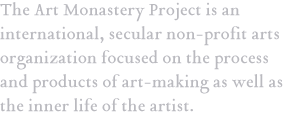‘looking at the contours of the temple’
[Part of a new series, Daily Lectio Divina after the Benedictine tradition of “divine reading.” For instructions, click here. Subscribe to  Daily Lectio Divina. Send comments or suggested readings to nathan@artmonastery.org]
Daily Lectio Divina. Send comments or suggested readings to nathan@artmonastery.org]
Attention… is a lucid ‘presence to oneself’ that becomes discernment of the presence of God in the human person. Basil, commenting on the Bible verse ‘Be careful’ (Deuteronomy 15.9), writes, ‘Pay attention to yourself if you want to pay attention to God.’ This attention to ourselves means resisting the thoughts that distract us by drawing us away from our centre, and it becomes a way of guarding the heart: ‘Attention is the silence of the heart uninterrupted by thoughts’ (Hesychius of Batos). There is an aspect of struggle inherent in attention that involves keeping watch over the thoughts that appear in the heart, recognizing their nature and origin, destroying those that are harmful, and resisting the suggestion of a harmful thought before it becomes dialogue (inner conversation with the thought) and results in action, or consumption of sin. Through this process, attention purifies the heart and becomes prayer. The Greek fathers took advantage of the similarity between the words prosoche (attention) and proseuche (prayer) to demonstrate how closely the two realities are related to each other. ‘Attention that seeks prayer will find it, because prayer follows attention, and it is to the latter that we should apply ourselves’ (Evagrius Ponticus); ‘Total attention is an aspect of continuous prayer’ (Hesychius of Batos).
Enzo Bianchi, Words of Spirituality. Towards a lexicon of the inner life
. (SPCK, 2002) 35-36.
Contemplation is by no means for mystics or monastics – it is a reality to which all the baptized are called, because every baptized person has been immersed in life in Christ (Romans 6.1-6) and clothed with Christ (Galatians 3.37), and Christian contemplative-knowledge has no other goal than that of making a Christian’s personal and ecclesial life resemble the life of Christ. In contemplation, the crucified Christ makes his presence visible on the face of the one who prays and perceptible in the testimony of the individual and the entire ecclesial community. A contemplative is not someone who separates him- or herself from others or tries to escape society, but a person who tries to discern in history, in people, in events and in his or her own person the presence of Christ. A contemplative’s gaze searches deeply enough to recognise that the temple of God (the verb ‘to contemplate’ refers us to templum and to the art of ‘looking at the contours of the temple’), the dwelling of the Holy Spirit, and the place where Christ lives is within the human being. The contemplative is an expert in the art of discerning God’s presence, a presence not relegated to sacred places and not limited to the religious, but diffused everywhere.
—Enzo Bianchi, Words of Spirituality. (SPCK, 2002) 48-49.
via Macrina Walker at avowofconversation.wordpress.com
Also of interest: Walker’s series on Andrew Louth’s “Afterword” to the new edition of his The Origins of the Christian Mystical Tradition: From Plato to Denys
Leave a Reply
You must be logged in to post a comment.




